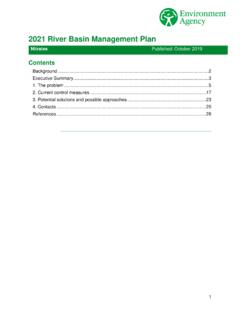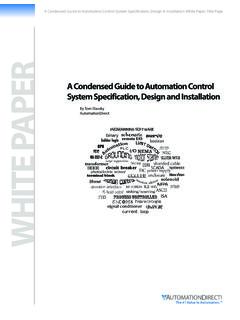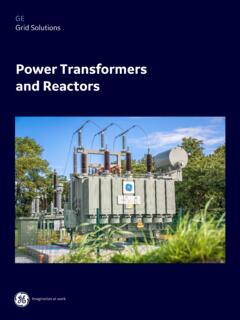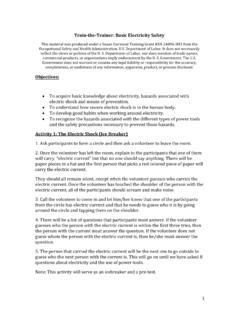Transcription of 1 Construction Noise and Vibration Management Plan
1 1 1 Construction Noise and Vibration Management Plan Objective This Management plan defines the measures to control and limit Noise emissions and Vibration levels, at residential properties and other sensitive receptors in the vicinity of the Project. The Contractor will discuss and agree with the Local Authority whether to seek their formal consent in accordance with Section 61 of Control of Pollution Act 1974 to his proposed methods of work and to the steps he proposes in order to minimise Noise . Notwithstanding this, the Contractor will discuss in detail and agree the proposed Noise and Vibration control measures with the Local Authority (Boston Borough Council). General Requirements Noise Best Practicable Means (BPM) of Noise control will be applied during Construction works to minimise Noise (including Vibration ) at neighbouring residential properties and other sensitive receptors arising from Construction activities.
2 The general principles of Noise Management are given below: Control at source: Equipment Noise emissions limits for equipment brought to site. Equipment method of directly controlling Noise by retrofitting controls to plant and machinery. Equipment - indirect method of controlling Noise acoustic screens. Equipment - indirect method of controlling Noise benefits and practicality of using alternative Construction methodology to achieve the objective vibratory piling techniques or hydro-demolition as opposed to more conventional but noisier techniques; selection of quieter tools/machines; application of quieter processes. Control across site by: Administrative and legislative control, Control of working hours, Control of delivery areas and times, Careful choice of compound location, Physically screening site, Control of Noise via Contract specification of limits, Noise Monitoring, to check compliance with Noise level limits, cessation of works until alternative method is found.
3 Many of the activities which generate Noise can be mitigated to some degree by careful operation of machinery and use of tools. This may best be addressed by tool box talks and site inductions. 2 Best Practicable Means BPM are defined in Section 72 of the Control of Pollution Act 1974 and Section 79 of the Environmental Protection Act 1990 as those measures which are: reasonably practicable having regard among other things to local conditions and circumstances, to the current state of technical knowledge and to financial implications . The Environment Agency will require its contractors to consider mitigation in the following order: BPM as identified above, including: Noise and Vibration control at source: for example the selection of quiet and low Vibration equipment, review of Construction methodology to consider quieter methods, location of equipment on site, control of working hours, the provision of acoustic enclosures and the use of less intrusive audible warnings such as broadband vehicle reversing alarms; Screening: for example local screening of equipment or perimeter hoarding.
4 And Where, despite the implementation of BPM, the Noise exposure exceeds the criteria defined in this Construction Noise and Vibration Management Plan, or where there are residents who would still be affected (eg shift workers, young mothers, the elderly, sick or disabled residents) the Agency would offer temporary relocation if required. These residents will be identified prior to works taking place. The recommendations of BS5228: 2009+A1:2014 Code of practice for Noise and Vibration Control on Construction and Open Sites , will be implemented, together with the specific requirements of this Management plan. Consultation Consultation was carried out with the environmental health department of Boston Borough Council during and subsequent to preparation of the Environmental Statement regarding the Management of Noise and Vibration during Construction of the Project.
5 The Council recognises that Construction operations by their nature are noisy, however the impact on those living and working in the vicinity must be minimised as far as is reasonably practicable. The Council requires the following in terms of regarding Noise and Vibration Management : 1) The maintenance of good community relations is vital. Experience shows that Construction Noise has the potential to cause disturbance but can be tolerated if prior warning and explanation has been given to residents. In particular advice regarding the nature of Construction works, the duration of the works and mitigation measures to be implemented can help to reduce people s reaction to Noise . Contractors will consult local residents/communities regarding works and to give them details of a responsible appointed person on site who will be able to deal with queries.
6 2) Construction working hours should be carefully managed. All works should take place between normal working hours 07:30 and 18:30, Monday to Friday with the exception of restricted works such as tide dependant dredging and any identified as planning conditions. 3) The local authority have no pre-defined Construction Noise limits however, it is requested that all works should employ best practicable means to control Noise levels as far as is reasonably possible. 3 4) A scheme of Noise and Vibration monitoring should be undertaken and assessed periodically during Construction . Monitoring would aim to demonstrate that Noise levels are being sufficiently controlled in order to protect residents from adverse Noise and Vibration levels.
7 [Details of such monitoring are outlined in Appendix C]. The Noise and Vibration Monitoring Plan is to be agreed with LA prior to commencement to include full term continuous monitoring at the nearest property to the Barrier works. 5) A pre-commencement external structural assessment of the properties closest to the Construction areas where Vibration is likely will be required. 6) Details of a 24/7 Complaints Procedure and Contacts to be agreed with LA Noise and Vibration Control Measures In addition to specific requirements of the Local Authority, the Contractor will be required to adopt the following more specific measures: Control measures Without prejudice to the other requirements of this section, the Contractor shall comply with the recommendations set out in BS5228:2009 and in particular with the following requirements: Vehicles and mechanical plant will be maintained in a good and effective working order and operated in a manner to minimise Noise emissions.
8 The contractor will ensure that all plant complies with the relevant statutory requirements; HGV and site vehicles will be equipped with broadband, non-tonal reversing alarms; Compressor, generator and engine compartment doors will be kept closed and plant turned off when not in use; All pneumatic tools will be fitted with silencers/mufflers; Care would be taken when unloading vehicles to avoid un-necessary Noise ; The use of particularly Noise plant will be limited, avoiding use of particularly noisy plant early in the morning; Restrict the number of plant items in use at any one time; Plant maintenance operations will be undertaken at distance from Noise -sensitive receptors; Reduce the speed of vehicle movements; Ensure that operations are designed to be undertaken with any directional Noise emissions pointing away from Noise -sensitive receptors; When replacing older plant, ensure that the quietest plant available is considered; Drop heights will be minimised when loading vehicles with rubble; Vehicles should be prohibited from waiting within the site with their engines running or alternatively, located in waiting areas away from sensitive receptors; Local hoarding, screens or barriers should be erected to shield particularly noisy activities.
9 Piling will be carried out with the method that minimises both Noise and the transmission of Vibration to sensitive receptors; 4 Temporary Noise screens will be used to reduce Noise from particularly noisy activities and the height of perimeter hoarding will be extended where this would assist in reducing Noise disturbance at sensitive receptors; and Hours of operation should be strictly enforced and any deviations other than those previously identified will be with the consent of the local authority. Notifications Occupiers of adjacent properties will be informed by the Contractor up to 2 weeks in advance of the works taking place, including the duration and likely Noise and Vibration effects.
10 In the case of work required in response to an emergency, the Environment Agency and local residents will be advised as soon as reasonably practicable that emergency work is taking place. Potentially affected residents will also be notified of the helpline number for the contractor. Noise and Vibration monitoring A regular programme of Noise and Vibration monitoring shall be implemented as a mimimum in accordance with Appendix C of this document. The Contractor will submit the proposed method, the frequency and the location of monitoring site to the Planning Authority for agreement prior to commencing works. Proposed monitoring requirements and locations are detailed in Appendix C. Noise baseline levels will be agreed prior to commencement of Construction .






![J1. Definitions [rps/rcp/rp/dp] - Auckland Council](/cache/preview/d/d/2/a/0/8/d/0/thumb-dd2a08d06e371f3ed80cf4e9fa2dd563.jpg)
